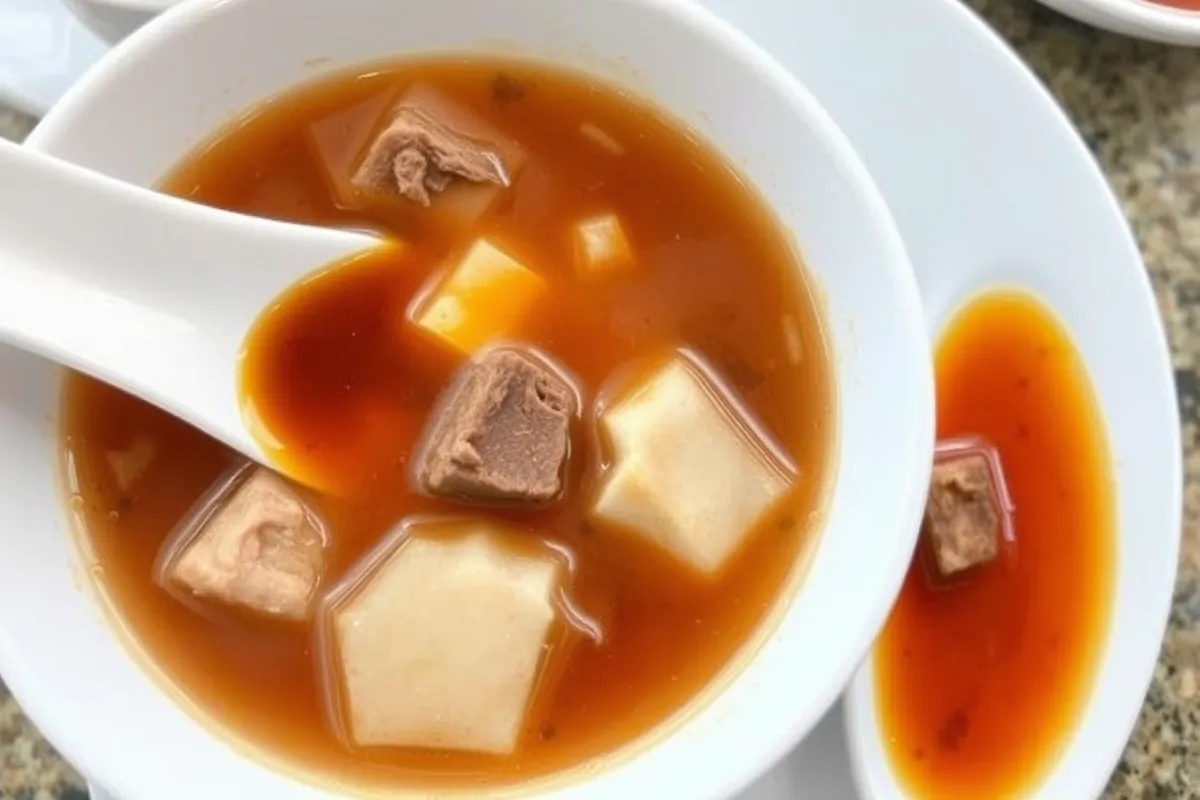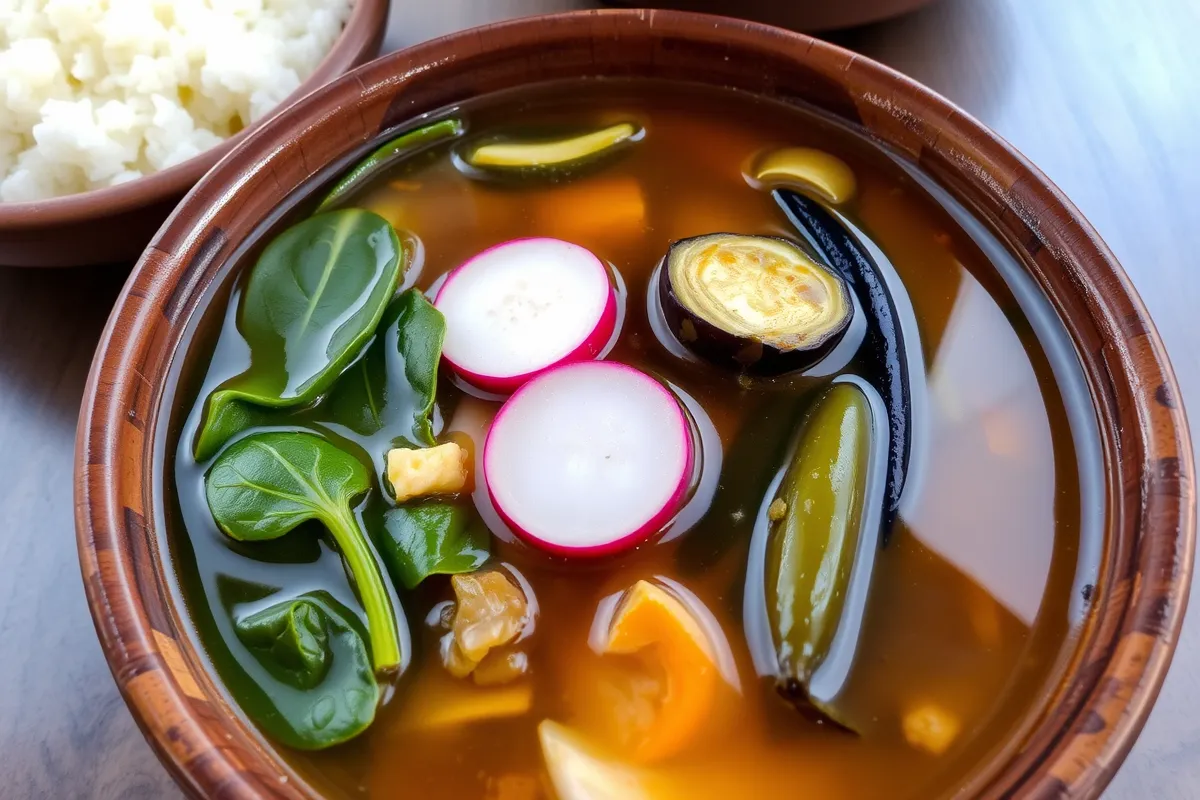Is Filipino Sinigang Healthy? Exploring Nutritional Benefits and Drawbacks
When you think of Filipino cuisine, Sinigang is likely one of the first dishes that come to mind. It’s a hearty, sour soup made from a mix of vegetables and proteins, with a tamarind-based broth that gives it its signature tangy flavor. But, is Filipino Sinigang healthy? That’s the question we’ll answer in this article by exploring its nutritional profile, potential benefits, and even a few possible drawbacks. Whether you’re someone who enjoys this dish regularly or are curious about trying it, we’ll break down everything you need to know about Sinigang and how it fits into a healthy diet.
Introduction and Overview
What is Filipino Sinigang?
Sinigang is a traditional Filipino soup that holds a special place in the hearts of many. It’s one of those comfort foods that’s passed down through generations, often enjoyed on rainy days or during family gatherings. The main ingredients typically include a souring agent, such as tamarind, and a variety of vegetables like spinach, okra, eggplant, radish, and tomatoes. The soup can be made with different types of protein, including fish, shrimp, or chicken.
While the most traditional version is made with beef, there are several healthier alternatives that we’ll discuss later. Each family may have its own version, but the common thread that ties all Sinigang dishes together is the distinct sour flavor that comes from tamarind or sometimes guava, green mango, or calamansi.
Different Variations of Sinigang
There are numerous versions of Sinigang depending on regional influences or the availability of ingredients. Some of the most popular variations include Sinigang na Baboy (beef Sinigang), Sinigang na Isda (fish Sinigang), Sinigang na Hipon (shrimp Sinigang), and even vegetarian versions where tofu replaces meat. Each of these versions provides a slightly different nutritional profile, which we’ll explore in more detail soon.
Sinigang’s Role in Filipino Cuisine
As a staple in the Filipino diet, Sinigang is more than just a meal—it’s a cultural experience. This soup is often served as the main dish, accompanied by a side of steamed rice. Despite its simple ingredients, it packs a lot of flavor, and because it’s typically made from scratch, it retains most of its nutritional value.
Nutritional Profile of Sinigang
Now, when we’re asking, “Is Filipino Sinigang healthy?”, it’s essential to look at its nutritional profile. At its core, Sinigang is a broth-based soup, which generally makes it a lower-calorie option compared to many other dishes in Filipino cuisine. However, the specific nutritional content can vary greatly depending on the ingredients used.
Key Ingredients and Their Nutritional Benefits
The healthiness of Sinigang largely depends on the type of protein and vegetables you add. If you’re using fish or shrimp as your protein source, the dish is packed with omega-3 fatty acids, which are fantastic for heart health. Vegetables like spinach, okra, and eggplant offer a variety of vitamins and minerals, including vitamin A, vitamin C, fiber, and antioxidants. Not to mention, the sour broth made from tamarind or other souring agents also contains vitamin C and can aid digestion.
Caloric Content of Sinigang
On average, a bowl of Sinigang can range from 200 to 300 calories per serving, depending on the type of meat and the portion size. Fish-based Sinigang tends to be on the lower end of the calorie spectrum, while beef-based versions can be a bit heavier due to the fat content of the meat. Regardless, it’s still relatively light compared to fried dishes or dishes cooked with coconut milk.
Macronutrients and Micronutrients
- Protein: The main protein source—whether it’s fish, shrimp, or chicken—provides the bulk of the protein in Sinigang, making it a filling meal without being too heavy.
- Carbohydrates: The vegetables contribute to the carbohydrate content, though these are complex carbs, meaning they’re packed with fiber, which aids digestion and helps maintain stable blood sugar levels.
- Fats: The fat content is largely dependent on the meat used. Fish and shrimp are leaner options, while beef contains more saturated fat, which could be a downside if consumed in large quantities.
This balance of nutrients makes Sinigang a nutrient-dense meal, especially when it’s packed with vegetables. In fact, for those aiming to eat a healthier diet, Sinigang can be a fantastic addition, particularly when prepared with lean protein and plenty of vegetables.
For those interested in learning more about the specific health benefits of tamarind, you can check out the health benefits of tamarind in soups to better understand how this souring agent contributes to both the flavor and health profile of Sinigang
Health Benefits of Sinigang
Is Sinigang Good for Digestion? Is Filipino Sinigang Healthy?
If you’re wondering whether Sinigang can help with digestion, you’re in for some good news. The combination of tamarind, vegetables, and clear broth makes it a soup that’s not only delicious but also beneficial for your gut health. Tamarind, the star ingredient that gives Sinigang its iconic tang, plays a significant role in this.
The Role of Tamarind in Aiding Digestion
Tamarind is a well-known digestive aid. Its sour properties stimulate bile production in the liver, which helps in breaking down food, especially fatty meals. Tamarind also contains tartaric acid, malic acid, and potassium, which can help improve digestion and prevent bloating.
High Fiber Content from Vegetables
Another digestive benefit of Sinigang comes from the vegetables. The dish usually includes a variety of fiber-rich veggies like spinach, radish, okra, and eggplant. Fiber is essential for digestive health as it helps regulate bowel movements and prevents constipation. These vegetables also promote the growth of good bacteria in the gut, supporting a healthy microbiome.
Benefits of a Clear Broth
The clear broth in Sinigang is easy to digest and can soothe the stomach, especially after a heavy meal. Because it’s a low-fat liquid base, it doesn’t overwhelm the digestive system, making it a perfect dish for those recovering from an illness or dealing with digestive issues.
Sinigang as a Low-Calorie Meal Option
Looking for a light yet satisfying meal? Sinigang can easily fit into a calorie-controlled diet. It’s naturally low in calories, especially when compared to many other Filipino dishes like kare-kare or lechon kawali, which are higher in fats and oils.
How Sinigang Fits into a Calorie-Controlled Diet
Because Sinigang is mainly broth-based, its caloric content is quite low. Even when prepared with meat, the soup still provides fewer calories than fried or creamy dishes. For example, a typical bowl of fish Sinigang can range from 200 to 250 calories, making it an excellent choice for those trying to lose weight or maintain a healthy diet.
Comparison to Other Filipino Dishes
When you compare Sinigang to other Filipino favorites, it clearly stands out as a lower-calorie option. Dishes like adobo, which are cooked in oil or kare-kare, which contains peanut sauce, can easily reach 500-600 calories per serving. On the other hand, the broth in Sinigang contains no added fats, keeping the calorie count in check.
Variations of Sinigang That Are Lower in Calories
If you want to make Sinigang even lighter, opt for seafood or vegetarian versions. Fish-based Sinigang, especially made with bangus (milkfish) or shrimp, provides a lean source of protein and heart-healthy fats. On the other hand, vegetarian versions replace meat with tofu or additional vegetables, bringing the calorie count down even further without sacrificing flavor. Sinigang with tofu or purely plant-based ingredients can dip below 200 calories per serving.
Sinigang and Heart Health (Is Filipino Sinigang Healthy? )
Another reason why Sinigang is a great addition to your diet is its potential benefits for heart health. Depending on the ingredients you use, this dish can be quite heart-friendly, particularly when made with seafood.
Low-Fat and Low-Cholesterol Properties of Fish-Based Sinigang
When made with fish or shrimp, Sinigang becomes a low-fat, low-cholesterol dish. Fish is an excellent source of lean protein without the saturated fats found in red meats like beef. This makes it an ideal meal for those watching their cholesterol levels or trying to reduce their intake of unhealthy fats.
Omega-3 Fatty Acids in Seafood Sinigang
Seafood-based Sinigang brings in the added benefit of omega-3 fatty acids, especially if you use fatty fish like bangus (milkfish). These essential fats are known to reduce inflammation, lower triglyceride levels, and improve overall heart health. Regular consumption of omega-3-rich foods has been shown to reduce the risk of heart disease and stroke, making fish Sinigang an excellent choice for heart-conscious individuals.
Health Benefits of Vegetables Commonly Used in Sinigang
Let’s not forget about the vegetables, which pack their own punch of heart-healthy benefits. Spinach and radish are rich in antioxidants, fiber, and potassium, all of which help regulate blood pressure and support cardiovascular health. Eggplant, another popular ingredient, contains phytonutrients that promote healthy blood flow and help lower cholesterol levels. All these ingredients come together to create a meal that nourishes your heart without compromising on taste.
Potential Downsides of Sinigang
Sodium Content in Sinigang
While Sinigang has plenty of health benefits, one area of concern is its sodium content, especially if prepared with store-bought fish sauce or broth cubes. These ingredients can cause the sodium levels to spike, which could pose a risk for those managing their blood pressure or heart health.
The Potential High Sodium Content from Fish Sauce or Broth Cubes
Fish sauce, a common ingredient in many Filipino dishes, is high in sodium. A tablespoon of fish sauce can contain up to 1,200 milligrams of sodium, which is half the recommended daily intake. Additionally, using broth cubes, another common shortcut in Filipino cooking, can significantly increase the sodium content of the dish.
Recommended Adjustments to Lower Sodium Levels
To make Sinigang healthier, consider reducing the amount of fish sauce or using low-sodium alternatives. Another option is to make your own broth from scratch, avoiding pre-packaged cubes. You can also add more fresh vegetables to the dish, which naturally contain potassium, helping balance out the effects of sodium.
Health Risks of High Sodium Intake
Consuming too much sodium can lead to high blood pressure, which is a major risk factor for heart disease and stroke. For those looking to keep their sodium intake in check, it’s important to be mindful of how much fish sauce or salt is being used in their Sinigang. Always taste the broth first before adding more seasoning!

The Impact of Meat Choices on Health
Choosing the right protein for your Sinigang can have a significant impact on its overall healthiness. While Beef-based Sinigang is the most traditional version, it may not always be the healthiest option.
Comparing Beef-Based Sinigang vs. Seafood or Chicken-Based
Beef, especially fatty cuts like Beef belly, can increase the fat and calorie content of Sinigang. A serving of Beef Sinigang contains more saturated fats compared to its fish or chicken counterparts, making it a less heart-healthy option.
Saturated Fats in Beef Sinigang
Beef Sinigang made with fattier cuts of meat tends to be higher in saturated fats, which can raise your LDL (bad) cholesterol levels and contribute to heart disease if consumed in excess. While the occasional indulgence is fine, eating beef-based Sinigang regularly may not be the best choice for those trying to maintain a heart-healthy diet.
Healthier Alternatives to Traditional Meats Used in Sinigang
For a healthier take on Sinigang, opt for leaner meats like chicken or seafood. Chicken breast provides a low-fat source of protein, while fish offers heart-healthy fats. Alternatively, tofu or tempeh can be used as a plant-based protein option, making the dish suitable for vegetarians while keeping the calorie and fat content low.
Allergies and Dietary Restrictions (Is Filipino Sinigang Healthy?)
While Sinigang is a versatile dish, there are a few dietary considerations to keep in mind, especially for people with allergies or food intolerances.
Common Allergens in Sinigang (Shrimp, Fish)
Many versions of Sinigang use seafood, such as shrimp or fish, which are common allergens. If you have a seafood allergy, it’s best to avoid these versions and opt for chicken or vegetarian alternatives.
Adjustments for People with Food Intolerances
If you have a food intolerance, you can easily modify Sinigang to suit your needs. For example, those who are sensitive to certain souring agents, like tamarind, can use other options such as calamansi or green mango.
Gluten-Free and Dairy-Free Aspects of Sinigang
The good news is that Sinigang is naturally gluten-free and dairy-free, making it suitable for individuals with celiac disease or lactose intolerance. As long as you avoid any pre-made sauces or seasonings that may contain hidden gluten, you’re good to go!
FAQs about Sinigang’s Healthiness
Is Sinigang Good for Weight Loss?
Yes, Sinigang is a great option for weight loss due to its low-calorie and high-nutrient profile. Since it’s broth-based, it provides a satisfying meal without being too heavy, making it easier to manage calorie intake. The combination of lean protein and fiber from vegetables keeps you full for longer, reducing the likelihood of overeating.
Can Sinigang Be Part of a Low-Sodium Diet?
Absolutely, but adjustments are needed. To make Sinigang fit into a low-sodium diet, you can reduce or eliminate the fish sauce and opt for low-sodium broth or make your own from scratch. Flavor can still be enhanced through the use of fresh herbs and spices without relying on salt.
What Are the Healthiest Ingredients to Use in Sinigang?
For a healthier Sinigang, choose ingredients like fish, shrimp, or chicken breast for protein. Incorporating vegetables such as spinach, radish, and eggplant boosts the fiber, vitamins, and minerals. These ingredients are packed with antioxidants and low in calories, making your meal both hearty and nutritious.
How Can I Reduce the Fat Content in Sinigang?
To reduce the fat content in Sinigang, opt for lean proteins such as seafood, chicken breast, or even tofu. You can also skim off excess fat from the surface of the broth after cooking. Avoid using fatty cuts of beef, as these will significantly raise the fat and calorie content of the dish.
Is Sinigang Suitable for People with High Cholesterol?
Yes, seafood-based Sinigang is an excellent choice for those managing high cholesterol. Fish and shrimp are lower in cholesterol and saturated fats compared to beef. Plus, the omega-3 fatty acids found in fish can help lower cholesterol and improve heart health.
What Makes Sinigang Different from Other Filipino Soups in Terms of Health?
Sinigang stands out due to its sour broth, which aids digestion and stimulates appetite. Compared to other Filipino soups, Sinigang uses more vegetables, offering a higher fiber content, and the broth itself is lighter, lower in fat, and typically free from heavy oils or creams.
Conclusion
Final Verdict: Is Filipino Sinigang Healthy?
So, is Filipino Sinigang healthy? The answer is a resounding yes, but with a few caveats. Sinigang offers numerous health benefits, especially when made with lean protein and packed with fiber-rich vegetables. It’s low in calories, can support heart health, and its clear broth is easy on digestion. The presence of omega-3 fatty acids in seafood-based versions further boosts its nutritional profile.
To enjoy Sinigang as part of a healthy, balanced diet, consider customizing it based on your health goals. Opt for lower-sodium versions and choose lean meats like fish or chicken. Adding extra vegetables and controlling portion sizes can make this beloved dish both delicious and nutritious. Remember, moderation is key—so enjoy your Sinigang, but be mindful of how it’s prepared!

